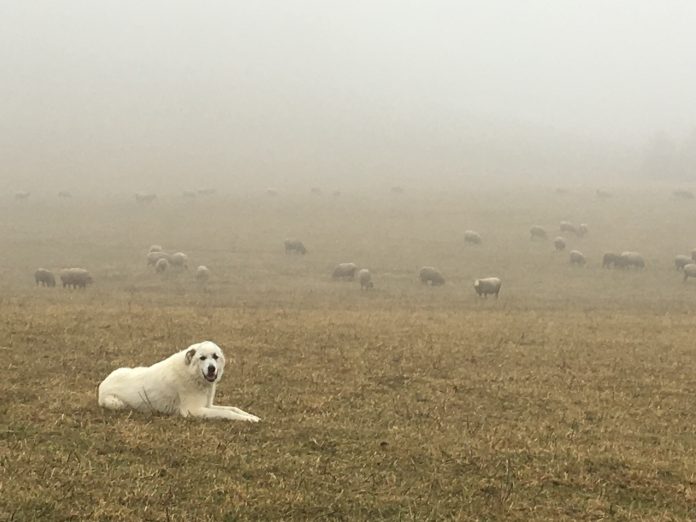Let me warn you now. Talk with me for any length of time, and chances are, dogs will come up in the conversation.
I spent most of my life saying, vehemently, I wasn’t a dog person. That has changed in the past few years, and I have livestock guardian dogs to thank.
One, in particular, actually. His name is Houdini, and he was the first livestock guardian dog I trained. A few years ago, my mom got a phone call. A teenage livestock guardian dog wasn’t fitting in as a house companion. Were we interested? I met her eyes across the dining room table and nodded. Sure. Why not?
I had no idea what I was getting into.
Meet Houdini
The first day, his former owner pulled into the barnyard and out hopped this lanky 11⁄2-year-old Akbash-Great Pyrenees, all legs, fluffy white fur and curly tail. The man passed the leash over, we chatted, and he drove away.
An hour later, the dog was gone, flying out our open gate. We drove around, searching. We even called the former owner, in case the dog decided to go back.
I will never understand how or why, but not long after we gave up, he came trotting back up the driveway. It was like he took a spin around the neighborhood, scoped things out, decided it suited, came back and said, in his dog-like way, “I’m in.”
Livestock guardian history
Livestock guardian dogs date back thousands of years. Various types hail from parts of Asia, the Middle East and Europe. They lived with shepherds, followed flocks and herds and spent time in villages during the off seasons.
They have only been in the U.S. for the past several decades, however, but are gaining popularity as a non-lethal method of predator control.
But back to Houdini. Over the following months, I worked with him as best I knew how. In other words, I tried to use common sense. He latched onto me, immediately. As a dog that bonded to humans before livestock, he showed me the value of a shepherd’s relationship with a livestock guardian.
He made the transition to livestock guardian on his own. One day, he was a glorified yard dog. The next, he wasn’t — he went out into the pastures and watched over the sheep from dusk until dawn, patrolling aggressively and pushing back our opportunistic coyote population.
He had learned to value my sheep because I do. It has been the foundation for how I work with the other livestock guardian dogs I’ve brought onto the farm.
I can’t say the ensuing years have been easy. He earned “Houdini” within 24 hours. He has shown me time and time again, though, that he is all in when it comes to protecting what I hold dear.
Complex relationship
It’s a different relationship than, say, with my border collie. It’s richer and more complex. I still don’t understand it entirely.
These dogs have the ability to reason, unlike most domesticated dogs. They’re primitive — they were meant to protect the weak and vulnerable, while having the ability to outthink and outmaneuver predators. They’re about as close to wolves as you can get, in some ways.
See? Get me started, and it’s hard to stop.
Dogs are different
Let me add a little science to the mix though. In an article just released June 17 in the Proceedings of the National Academy of Sciences journal, researchers add a little piece of the puzzle as to how domesticated dogs are different then wolves.
“Dogs, but not wolves, establish eye contact with humans when they cannot solve a problem on their own,” the researchers write about recent findings.
But they add to it with their own research. There are two types of muscles dogs have that allow for more expressions. Wolves, and even older breeds, like huskies, don’t have them.
I suspect the same can be said for livestock guardian dogs. To put it in layman’s terms, they are intelligent, but often, don’t need your approval to prove that intelligence. I rarely find any of my guardians staring soulfully up at me. They show their respect in other ways.
Hiking with Houdini
Recently, Houdini and I went hiking.
I like to give him, and my other livestock guardians, breaks from the farm, now and then.
While it was a rare dry day, the humidity was building, and mud and bugs plagued us most of the way. Houdini gave me a couple of looks, like, “Really, we’re doing this? OK, if you insist.” As is the way of these large dogs though, he bore it gracefully.
As we hiked the single-track trail, I saw a pattern emerge. At times, Houdini forged ahead. He’s meticulous about keeping clean — I know, funny for an outdoor dog — and picked his way carefully over the muddiest spots. Other times, he would let me go ahead and choose the best way to cross a downed tree. Sometimes, we walked side by side.
It wasn’t overt. I have spent a lot of time observing his habits to try to understand him. But I found it to be telling.
We are a team. And that’s what makes my work as a shepherdess more fulfilling. Not only do I have family to rely on, but my livestock guardians, too.













